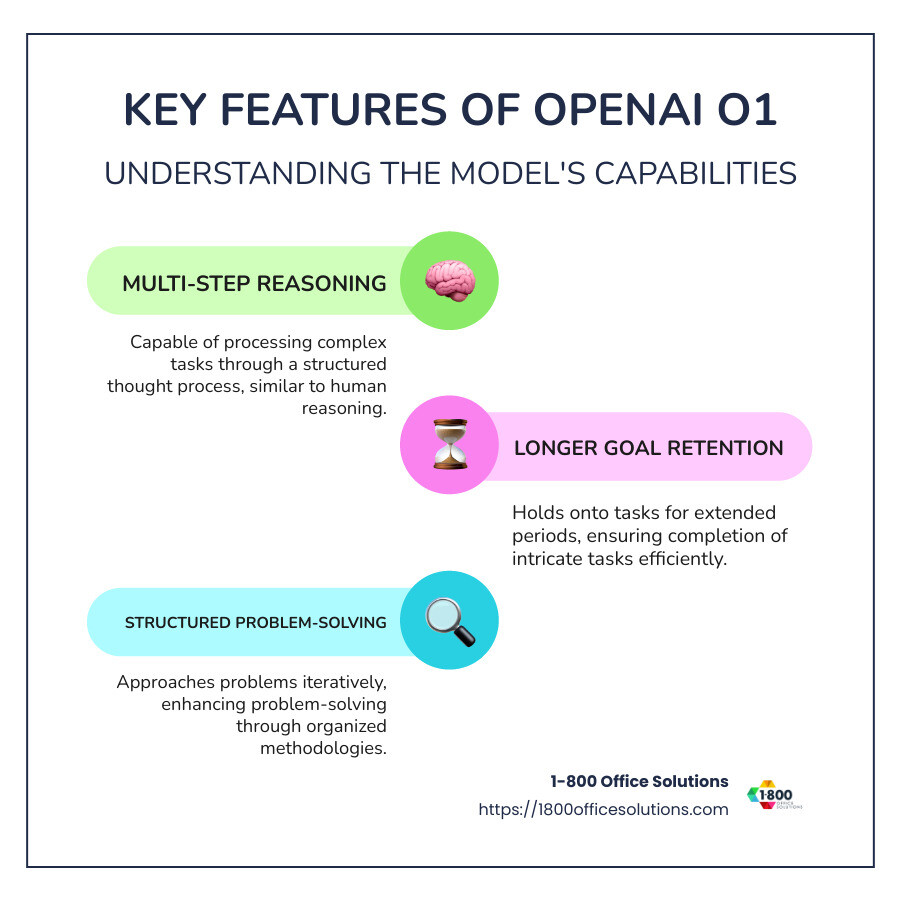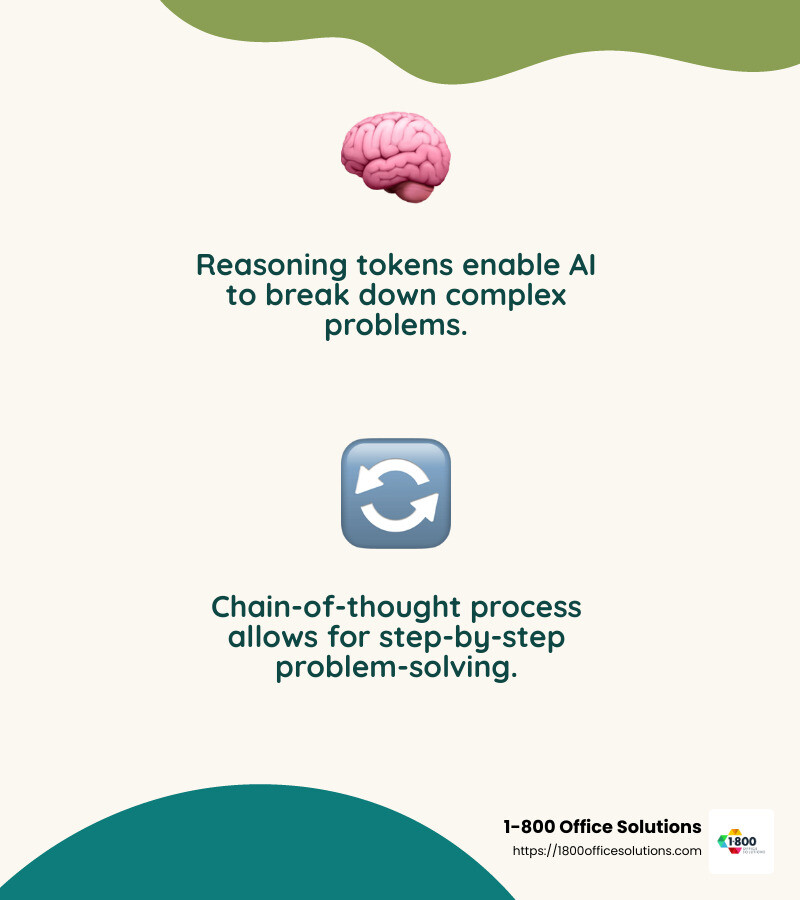An Essential Guide to Understanding OpenAI O1
OpenAI o1 Explained is a fascinating topic that holds the potential to change how artificial intelligence interacts with complex tasks. In simple terms, OpenAI o1 is a model designed to improve upon existing AI technologies by enhancing multi-step reasoning capabilities. This means the ability to hold onto goals for longer periods and to solve advanced problems with a structured thought process.
- What is OpenAI o1?
It’s an AI model focusing on reasoning and advanced task handling. - Why is it unique?
Unlike previous AI models, OpenAI o1 can manage complex ideas step-by-step, similar to human thinking.

What is OpenAI O1?
OpenAI O1 is a cutting-edge AI model that stands out due to its unique approach to problem-solving and reasoning. Reasoning tokens are at the heart of what makes O1 special. These tokens allow the AI to break down complex problems into smaller, manageable steps, much like how humans think through a problem.
Chain-of-Thought
One of the key techniques employed by OpenAI O1 is the chain-of-thought process. This method encourages the model to “think out loud,” generating a sequence of thoughts that lead to a solution. Imagine solving a math problem by writing out each step; this is similar to how O1 processes information. By doing so, it can handle intricate tasks and provide more accurate answers.
Advanced Training
The development of OpenAI O1 involved advanced training techniques that go beyond traditional methods. This includes using high-quality data curated by experts and employing reinforcement learning to refine its responses. The goal is to ensure that the AI not only understands complex queries but also responds in a way that feels natural and human-like.

By integrating these innovative approaches, OpenAI O1 sets a new benchmark for AI models, enabling them to tackle complex tasks with a level of sophistication previously unseen. This makes O1 an invaluable tool for businesses looking to leverage AI for advanced problem-solving and decision-making.
Key Features of OpenAI O1
OpenAI O1 is packed with features that make it a standout in AI, particularly when it comes to handling complex tasks. Let’s explore what makes it so special.
Complex Tasks
OpenAI O1 excels at tackling tasks that require deep, nuanced understanding. Whether it’s solving intricate logic puzzles or performing complex calculations, O1 uses its advanced reasoning capabilities to break down problems into smaller parts. This makes it incredibly effective at tasks that were previously challenging for AI models.
Debugging Code
One of the standout features of OpenAI O1 is its ability to debug code. Imagine you’re a developer stuck on a tricky bug. O1 can step in, analyze the code, and offer solutions by identifying errors and suggesting corrections. Its proficiency in programming and debugging is a game-changer for software developers, saving time and reducing frustration.
Multi-Step Reasoning
Multi-step reasoning is another area where OpenAI O1 shines. Unlike simpler models that might get lost in complex problems, O1 can plan and execute a sequence of steps to arrive at a solution. This is akin to how humans tackle big challenges by breaking them down into manageable pieces. For instance, O1 can solve riddles by logically piecing together clues, offering a clear path to the answer.
OpenAI o1 explained through these features shows how it goes beyond being just a conversational agent. It acts more like a problem-solving partner, capable of understanding and addressing sophisticated issues with ease. This makes it an indispensable tool for anyone looking to harness the power of AI for intelligent decision-making and problem-solving.
How OpenAI O1 Works
Understanding how OpenAI O1 operates is like peeking into the mind of a diligent problem-solver. This AI model doesn’t just spit out answers—it thinks through problems using a methodical approach.
Internal Thought Process
At the heart of O1’s capabilities is its internal thought process. Think of it as the AI’s way of “talking to itself” to figure things out. Much like how a student might jot down notes while solving a math problem, O1 generates “reasoning tokens.” These tokens help it break down complex tasks into simple steps, allowing it to focus on one piece at a time. This process resembles how humans process information, making O1’s responses more relatable and understandable.
Iterative Approach
O1’s problem-solving strength lies in its iterative approach. It doesn’t just dive head-first into a problem and hope for the best. Instead, it takes a step-by-step route, revisiting and refining its answers as needed. This approach is similar to how a writer might draft and redraft a story, ensuring each version is better than the last. By iterating, O1 can handle complex problems that require multiple layers of reasoning, making it a reliable partner for tasks that demand precision.
Problem-Solving
When it comes to problem-solving, O1 is like a seasoned detective piecing together evidence. It tackles issues by breaking them down into manageable parts, analyzing each component, and then synthesizing the information to form a coherent solution. For example, in debugging code, O1 identifies errors and proposes corrections, much like a developer carefully checking each line of code. This capability transforms O1 from a mere tool into a valuable collaborator in complex problem-solving scenarios.
OpenAI o1 explained through its internal thought process, iterative approach, and problem-solving prowess, showcases its ability to think and reason like a human. This level of sophistication is what sets O1 apart, making it a powerful asset for anyone in need of advanced AI-driven solutions.
OpenAI O1 Explained
OpenAI O1
is an advanced AI model that brings a new level of intelligence to the table. It is specifically designed to mimic human-like reasoning, making its responses feel more natural and relatable.
Improved Reasoning
One of the standout features of OpenAI O1 is its improved reasoning capability. Unlike previous models, O1 doesn’t just provide quick answers. Instead, it takes the time to “think” through problems, much like a person would. This deliberate process enables O1 to tackle complex tasks with greater accuracy and depth. By using reasoning tokens, O1 can break down intricate problems into smaller parts, allowing it to focus on each element systematically.
Human-Like Responses
O1’s ability to deliver human-like responses is another remarkable aspect. When interacting with this model, users often find its answers to be more intuitive and relatable. This is because O1 has been trained to refine its thinking process, trying different strategies and recognizing mistakes along the way. The result is an interaction that feels less like talking to a machine and more like conversing with a thoughtful human being.
O1-Preview
The o1-preview is a version of this model that has been eagerly anticipated due to its improved reasoning abilities. It has been described as performing similarly to PhD students on challenging tasks in fields like physics, chemistry, and biology. This makes it particularly useful in academic settings, where complex problem-solving is required. The o1-preview isn’t just about answering queries; it’s about understanding the questions deeply and providing well-thought-out solutions.
In summary, OpenAI O1 explained through its improved reasoning, human-like responses, and the o1-preview, demonstrates a significant leap in AI technology. This model is not just a tool but a partner in solving complex problems, offering insights that are both profound and practical.
Frequently Asked Questions about OpenAI O1
How does OpenAI O1 work?
OpenAI O1
uses a unique approach to problem-solving called reasoning tokens. These tokens allow the model to break down complex problems into smaller, manageable parts. This iterative approach helps O1 to process each step carefully, much like solving a puzzle piece by piece.
The model’s internal thought process is designed to mimic human reasoning. This means it doesn’t rush to conclusions but instead takes time to “think” through each problem. This method is particularly effective in tasks that require multi-step reasoning, making O1 a powerful tool for complex problem-solving.
Is OpenAI O1 the same as Strawberry?
Yes, OpenAI O1 was initially known as “Strawberry.” The o1-preview version of this model has gained attention for its improved reasoning abilities. It’s part of the ChatGPT model lineup, but with a focus on deeper analytical capabilities.
The o1-preview is not just a conversational tool; it’s designed to handle more complex queries, especially in academic fields like physics and biology. While it maintains the conversational ease of ChatGPT, it offers a more thoughtful and deliberate approach to problem-solving.
What makes OpenAI O1 different from previous models?
OpenAI O1
stands out for its advanced reasoning skills. Unlike earlier models that might provide quick but shallow answers, O1 digs deeper into problems. It uses an iterative approach to refine its responses, trying different strategies and learning from mistakes.
This makes O1 particularly adept at handling complex tasks, such as debugging code or conducting scientific research. The model’s ability to think through problems methodically means it can offer insights that are both profound and practical, setting it apart from previous AI iterations.
Conclusion
In our journey through understanding OpenAI O1, we’ve seen how it represents a significant leap forward in artificial intelligence. This model is not just about conversation; it’s about reasoning. It breaks down complex problems into smaller parts using reasoning tokens, allowing it to think through issues more deeply and effectively. This capability makes it an invaluable tool for tasks that require multi-step reasoning, such as scientific research and code debugging.
At 1-800 Office Solutions, we’re excited about the potential of integrating such advanced AI technologies into our services. As AI continues to evolve, it opens up new possibilities for enhancing productivity and efficiency in various fields. Whether you’re looking to streamline your office operations or explore the capabilities of AI in creative projects, our team is here to support you.
For more information on how AI can transform your business, visit our Printing and AI page. Let us help you harness the power of AI to achieve your goals.











